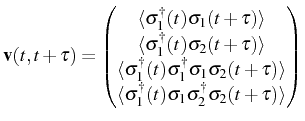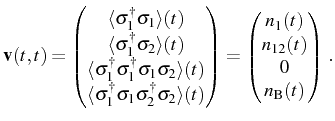First order correlation function and power spectrum
The luminescence spectrum of the system through the emission of one of
the dots,
![]() , requires the
correlator
, requires the
correlator
![]() in
Eq. (2.75). Let us write the quantum regression formula for the
most general set of
operators
in
Eq. (2.75). Let us write the quantum regression formula for the
most general set of
operators
![]() ,
with
,
with ![]() ,
, ![]() ,
, ![]() ,
,
![]() . The regression matrix
. The regression matrix ![]() is
defined by:
is
defined by:
and zero everywhere else.
![\includegraphics[width=0.8\linewidth]{chap4/manifolds/Fig6.ps}](img1045.png) |
For the computation of the spectrum, we need two more correlators and
equations than in the two coupled HOs (see
Fig. 3.2). In
Fig. 4.2 we can see a schema of this
finite set of correlators (left) and mean values (right), labelled
with the indices
![]() . The coherent
(through
. The coherent
(through ![]() ) and incoherent (through
) and incoherent (through ![]() ) links between the
various correlators, given by the regression matrix, are shown with
arrows (see a detailed explanation of the figure in the
caption). Thanks to the saturation of both modes, being 2LSs, we
obtain a simple equation,
) links between the
various correlators, given by the regression matrix, are shown with
arrows (see a detailed explanation of the figure in the
caption). Thanks to the saturation of both modes, being 2LSs, we
obtain a simple equation,
for the correlators
with the matrix
At low excitation, this system is reduced to the LM, where only the first two correlators and columns/rows of
The coefficients
Here, we have introduced some notation in order to highlight the meaning of each quantity:
If the QDs were uncoupled, we would have
Note that ![]() is also the population of state
is also the population of state ![]() (see
Fig. 4.1). The population of the
intermediate state
(see
Fig. 4.1). The population of the
intermediate state ![]() , and also the probabilities of having
only dot
, and also the probabilities of having
only dot ![]() excited, is given by
excited, is given by
![]() . The population of
the ground state is given by
. The population of
the ground state is given by
![]() . The last
interesting averages are the excitation of each dot,
. The last
interesting averages are the excitation of each dot, ![]() or
or ![]() ,
and the total excitation in the system,
,
and the total excitation in the system, ![]() .
.
In order to insert these average quantities in the expression for the
spectrum, they must be either time integrated in the SE case to give
![]() (and the
coefficients
(and the
coefficients
![]() ) or computed directly
in the SS to give
) or computed directly
in the SS to give
![]() (and the coefficients
(and the coefficients
![]() ). The normalized spectra for the
direct emission of dot
). The normalized spectra for the
direct emission of dot ![]() follows from our general expression as:
follows from our general expression as:
with
Subsections Elena del Valle ©2009-2010-2011-2012.


![\begin{subequations}\begin{align}&M_{\substack{mn\mu\nu\\ mn\mu\nu}}=i\omega_{E1...
...u\nu\\ m,1-n,\mu,1-\nu}}=-ig[n(1-\nu)+\nu(1-n)]\,, \end{align}\end{subequations}](img1037.png)




![$\displaystyle S_1(\omega)=\frac1{\pi}\sum_{p=1}^4\left[L_p\frac{\frac{\gamma_p}...
...{\omega-\omega_p}{\big(\frac{\gamma_p}{2}\big)^2+(\omega-\omega_p)^2}\right]\,,$](img1075.png)